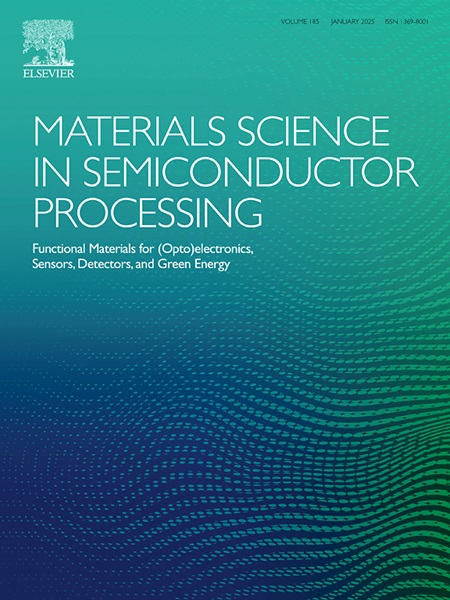Optical properties of carbon nitride thin films fabricated by rapid chemical vapor deposition
IF 4.2
3区 工程技术
Q2 ENGINEERING, ELECTRICAL & ELECTRONIC
引用次数: 0
Abstract
Developed rapid chemical vapor deposition lasting only 3 min allowed to produce smooth layered carbon nitride polycrystalline thin films as thick as 830–1547 nm at 550–625 °C in air with crystallites in the layers oriented parallel to the substrate (glass or silicon) surface. They are distinguished by high transparency in the visible range and the thickness uniformity. It made possible an adequate optical transmission and absorption spectra measurements at room temperature and their correct processing with the Swanepoel's envelope method to determine optical properties of the films and compare them with characteristics of carbon nitride materials obtained by conventional chemical vapor deposition or thermal polymerization. The application of the Swanepoel's method allowed to determine actual thickness of the films and then the refraction index of the material to be 2.50–3.25 and the extinction coefficient to be 0.1–0.4 as functions of the deposition temperature. The average photoluminescence lifetime of the deposited material is found to be 2.3–2.6 ns for high energy carrier recombination processes being the shortest in the sample fabricated at 550 °C and correlating with crystallinity of the film. Optimal temperature for rapid chemical vapor deposition of carbon nitride thin films is concluded to be in the range of 550–575 °C providing its best properties promising for electronic and optoelectronic applications.
快速化学气相沉积制备氮化碳薄膜的光学性质
开发了快速化学气相沉积,持续时间仅为3分钟,可在550-625°C的空气中产生厚度为830-1547 nm的光滑层状氮化碳多晶薄膜,其晶体平行于衬底(玻璃或硅)表面。其特点是在可见光范围内具有较高的透明度和厚度均匀性。这使得在室温下进行充分的光学传输和吸收光谱测量以及用斯瓦内普尔包络法对其进行正确处理成为可能,以确定薄膜的光学特性,并将其与传统化学气相沉积或热聚合获得的氮化碳材料的特性进行比较。应用斯瓦内普尔方法可以确定薄膜的实际厚度,然后材料的折射率为2.50-3.25,消光系数为0.1-0.4,作为沉积温度的函数。在550℃下制备的样品中,高能载流子复合过程的平均光致发光寿命为2.3-2.6 ns,与薄膜的结晶度有关。快速化学气相沉积氮化碳薄膜的最佳温度范围是550-575°C,为电子和光电子应用提供了最佳性能。
本文章由计算机程序翻译,如有差异,请以英文原文为准。
求助全文
约1分钟内获得全文
求助全文
来源期刊

Materials Science in Semiconductor Processing
工程技术-材料科学:综合
CiteScore
8.00
自引率
4.90%
发文量
780
审稿时长
42 days
期刊介绍:
Materials Science in Semiconductor Processing provides a unique forum for the discussion of novel processing, applications and theoretical studies of functional materials and devices for (opto)electronics, sensors, detectors, biotechnology and green energy.
Each issue will aim to provide a snapshot of current insights, new achievements, breakthroughs and future trends in such diverse fields as microelectronics, energy conversion and storage, communications, biotechnology, (photo)catalysis, nano- and thin-film technology, hybrid and composite materials, chemical processing, vapor-phase deposition, device fabrication, and modelling, which are the backbone of advanced semiconductor processing and applications.
Coverage will include: advanced lithography for submicron devices; etching and related topics; ion implantation; damage evolution and related issues; plasma and thermal CVD; rapid thermal processing; advanced metallization and interconnect schemes; thin dielectric layers, oxidation; sol-gel processing; chemical bath and (electro)chemical deposition; compound semiconductor processing; new non-oxide materials and their applications; (macro)molecular and hybrid materials; molecular dynamics, ab-initio methods, Monte Carlo, etc.; new materials and processes for discrete and integrated circuits; magnetic materials and spintronics; heterostructures and quantum devices; engineering of the electrical and optical properties of semiconductors; crystal growth mechanisms; reliability, defect density, intrinsic impurities and defects.
 求助内容:
求助内容: 应助结果提醒方式:
应助结果提醒方式:


